Social housing dwellings
Quick facts
- At 30 June 2018, there were around 436,200 social housing dwellings. This is an increase of less than 1% over the previous 12 months; a 6% increase since 2008–09.
- The majority of social housing dwellings were public housing stock in 2017–18 (72%, or 316,200 dwellings), consistent with historical trends.
- The number of community housing dwellings more than doubled over a decade, from 39,800 in 2008–09, to 87,800 in 2017–18, partly due to the transfer of ownership or management of public housing dwellings to community organisations.
- At 30 June 2018, New South Wales had the largest number of public housing and community housing dwellings, the Northern Territory had the most state owned and managed Indigenous housing (SOMIH) dwellings while for Indigenous community housing, from the available data, Queensland had the most.
- The greatest proportion of social housing dwellings were separate, 3-bedroom houses.
What is a dwelling?
For the purpose of this report, a dwelling is defined as a structure, or a discrete space within a structure, intended for a person or group of people to live. Dwelling types may include:
- a separate house
- a semi-detached, row or terrace house, townhouse, etc.
- a flat, unit or apartment; caravan, tent, cabin etc.
The concept of a dwelling may be different across the social housing collections, see the Data quality statements page for more information.
There is considerable diversity in the number and characteristics of dwellings offered by the 4 social housing programs; that is, public housing, community housing, state owned and managed Indigenous housing (SOMIH) and Indigenous community housing.
Number of dwellings and changes over time
At 30 June 2018, there were around 436,200 dwellings in social housing in Australia. Of these social housing dwellings:
- most (72% or 316,200 dwellings) were public housing
- 3% (14,700 dwellings) were state owned and managed Indigenous housing (SOMIH)
- 20% (87,800 dwellings) were community housing
- 4% (17,500 dwellings) were Indigenous community housing (Supplementary table DWELLINGS.1).
Changes over time
The social housing stock of Australia has increased over time, up 6% since 2008–09 (23,100 dwellings across the 4 social housing programs). More recently, there was an increase of less than 1% in the total number of social housing dwellings between 2016–17 and 2017–18 (almost 600 dwellings). There has been considerable change in provision of social housing through the 4 programs, with a gradual but steady policy focus on growing the community housing sector and transferring ownership and/or management of public housing stock to community housing organisations. In Australia, between 2008–09 and 2017–18, there was a 6% decrease in the number of public housing dwellings from 336,500 to 316,200 (Figure DWELLINGS.1); a decrease of around 20,200 dwellings.
The following data visualisation displays the number of dwellings in social housing for public housing and other social housing, from 2005–06 to 2017–18.
Data visualisation for figure dwellings.1: number of social housing dwellings, by social housing program, 2005-06 to 2017-18
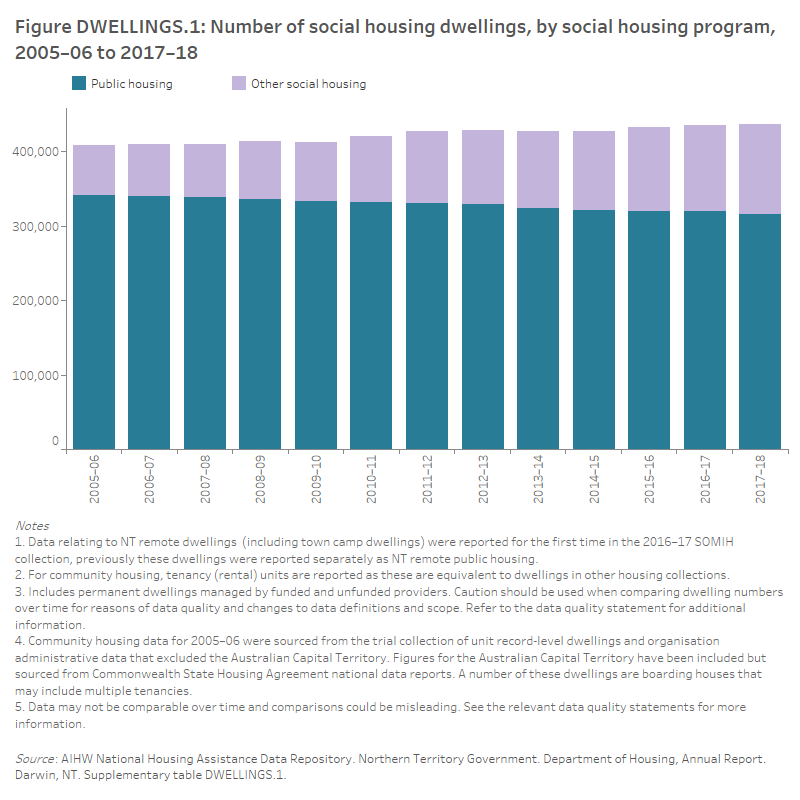
The reduction in public housing stock has been partly offset by the number of dwellings in community housing more than doubling (from 39,800 in 2008–09, to 87,800 dwellings in 2017–18; a 121% increase or 48,000 dwellings) (Figure DWELLINGS.2). The increase includes a recent 6% rise in the number of community housing dwellings, up from 82,900 dwellings in 2016–17.
There have also been changes in the management of dwellings between the Indigenous community housing, public housing and SOMIH programs. Between 2008 and 2010, around 5,000 dwellings were transferred from the Indigenous community housing collection to NT remote public housing. In 2016–17, these NT remote public housing dwellings were transferred into the SOMIH collection. These changes have driven most of the fluctuations in the numbers of SOMIH and Indigenous community housing dwellings over this time. More recently, the number of SOMIH dwellings has been fairly stable at around 15,000 dwellings in both 2016–17 and 2017–18. For Indigenous community housing, the number of dwellings decreased from 17,900 in 2016–17 to 17,500 in 2017–18 (Figure DWELLINGS.2).
The following data visualisation displays the number of dwellings in community housing, Indigenous community housing, SOMIH and NT remote public housing, from 2005–06 to 2017–18.
Data visualisation for figure dwellings.2: number of social housing dwellings, by social housing program type (excluding public housing), 2005-06 to 2017-18
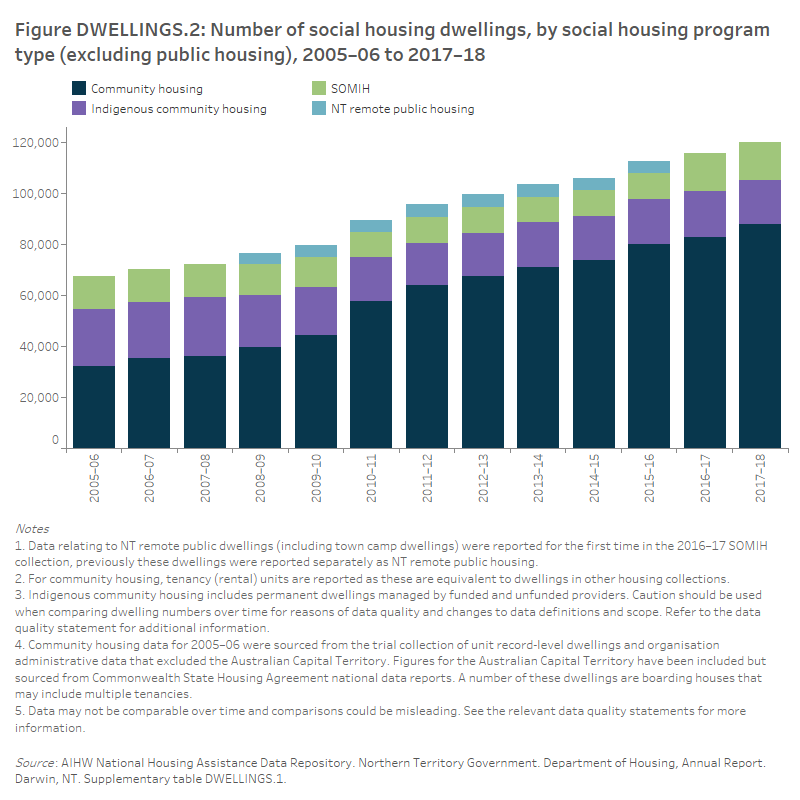
While the stock of social housing has increased each year, it has not kept pace with the growth in the number of households in Australia. Using the projected number of households in Australia (ABS 2015) the number of social housing dwellings per 100 households has declined from 5.1 per 100 households in 2007–08 to 4.6 in 2017–18 (Figure DWELLINGS.3).
The following data visualisation displays social housing dwellings per 100 households over time from 2007–08 to 2017–18.
Data visualisation for figure dwellings.3: social share, as social housing dwellings per 100 households in Australia, 2007-08 to 2017-18
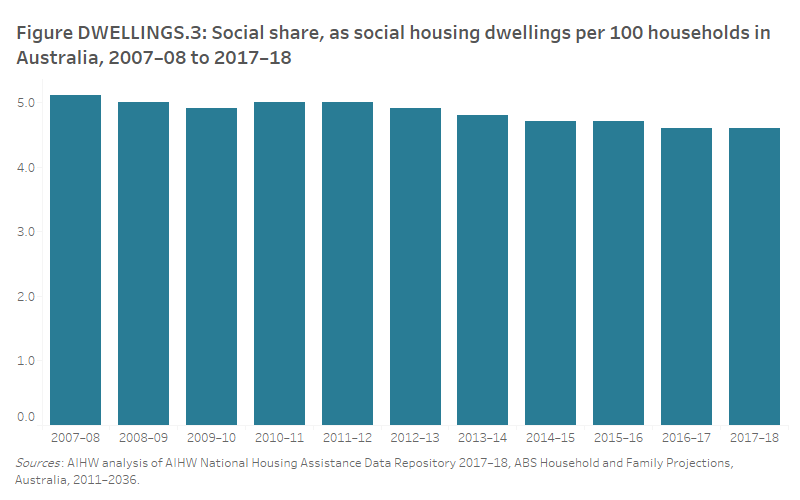
Location of dwellings
At 30 June 2018, New South Wales had the largest number of public and community housing dwellings (Tables DWELLINGS.1.1 and DWELLINGS.1.2). For Indigenous community housing, Queensland had the most dwellings reported. These results were similar to previous years. For SOMIH, the Northern Territory had the most dwellings which is similar to the previous year and reflects the transfer of around 5,000 households to the Northern Territory SOMIH program. At 30 June 2018, New South Wales had a similarly large number of SOMIH dwellings.
The five largest states (New South Wales, Victoria, Queensland, Western Australia and South Australia) have broadly similar social housing profiles, with the majority of dwellings in public housing (70–80%) followed by community housing (16–25%). In contrast, Tasmania and the Northern Territory had greater program diversity. In the Northern Territory, for example, 41% of dwellings were SOMIH dwellings and 15% were Indigenous community housing.
|
Social housing program |
NSW |
Vic |
Qld |
WA |
SA |
Tas |
ACT |
NT |
Aust. |
|---|---|---|---|---|---|---|---|---|---|
|
Public housing |
111,341 |
64,295 |
51,413 |
33,293 |
32,686 |
7,005 |
11,181 |
5,017 |
316,231 |
|
SOMIH(a) |
4,603 |
. . |
3,292 |
. . |
1,449 |
222 |
. . |
5,120 |
14,686 |
|
Community housing(b) |
35,345 |
14,486 |
11,116 |
8,062 |
11,561 |
5,980 |
895 |
374 |
87,819 |
|
Indigenous community housing(c) |
4,971 |
1,707 |
5,224 |
2,704 |
928 |
81 |
. . |
1,862 |
17,477 |
|
All programs |
156,260 |
80,488 |
71,045 |
44,059 |
46,624 |
13,288 |
12,076 |
12,373 |
436,213 |
|
Social housing program |
NSW |
Vic |
Qld |
WA |
SA |
Tas |
ACT |
NT |
Aust. |
|---|---|---|---|---|---|---|---|---|---|
|
Public housing |
71.3 |
79.9 |
72.4 |
75.6 |
70.1 |
52.7 |
92.6 |
40.5 |
72.5 |
|
SOMIH(a) |
2.9 |
. . |
4.6 |
. . |
3.1 |
1.7 |
. . |
41.4 |
3.4 |
|
Community housing(b) |
22.6 |
18.0 |
15.6 |
18.3 |
24.8 |
45.0 |
7.4 |
3.0 |
20.1 |
|
Indigenous community housing(c) |
3.2 |
2.1 |
7.4 |
6.1 |
2.0 |
0.6 |
. . |
15.0 |
4.0 |
|
All programs |
100.0 |
100.0 |
100.0 |
100.0 |
100.0 |
100.0 |
100.0 |
100.0 |
100.0 |
. . Not applicable
(a) NT data were reported for the first time in 2016–17.
(b) For community housing, tenancy (rental) units are reported as these are equivalent to dwellings in other housing collections.
(c) Includes permanent dwellings managed by funded and unfunded providers.
Notes
- Some percentages may not sum to 100% due to rounding.
- Data may not be comparable across jurisdictions and comparisons could be misleading. See the relevant data quality statements for more information.
Source: AIHW National Housing Assistance Data Repository. Supplementary table DWELLINGS.3.
The location of social housing overall reflects the geographic population distribution of Australia, with large concentrations seen in urban centres in the south-east and east coastal areas. Considering the 4 different social housing programs, the location of dwellings managed by each program reflects their differing target groups.
At 30 June 2018, the highest proportion of public and community housing dwellings were in Major cities (74% and 67%, respectively) (Figure DWELLINGS.4). The highest proportion of SOMIH and Indigenous community housing dwellings were in Very remote areas (30% and 47%, respectively). SOMIH remoteness findings included data from the Northern Territory for the first time in 2017–18.
The following data visualisation displays the distribution of dwellings in the four social housing programs by remoteness area, at 30 June 2018.
Data visualisation for figure dwellings.4: proportion (%) of social housing dwellings, by social housing program, by remoteness area, at 30 June 2018
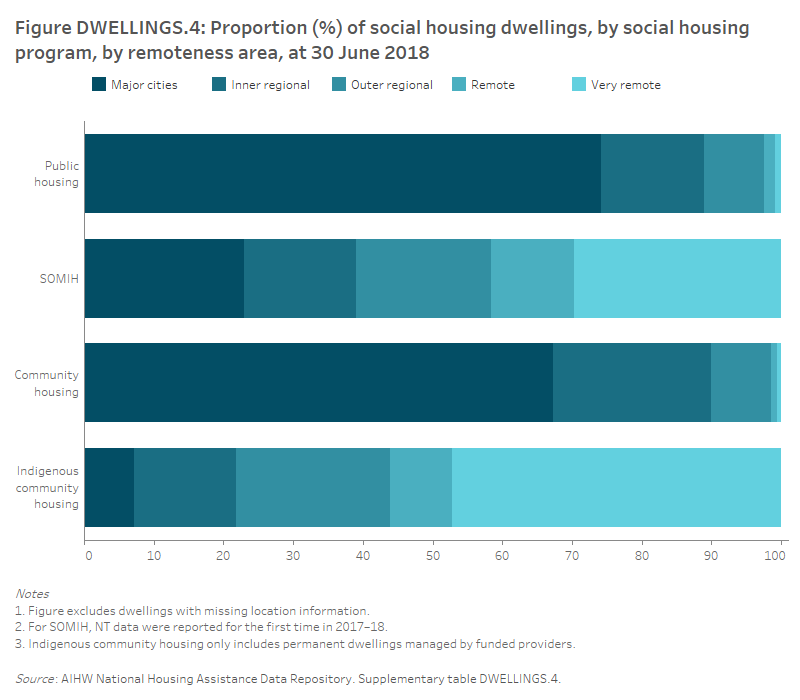
The location of social housing is an important component of suitability. Location is often associated with employment opportunities, health services, transportation services etc. (AIHW 2019). For further information on the suitability of social housing in terms of location, see the latest National Social Housing Survey 2018: Key results.
Additional information: Census of population and housing
The ABS Census results (ABS 2016) includes information on social housing dwellings at the statistical area level 3 (SA3). SA3 boundaries combine areas with similar regional characteristics and can range in size and population from as low as 30,000 up to 130,000 persons.
Census data includes information on the type of social housing provider, that is, state and territory governments and the community sector. At the 2016 Census, over 8 million Australian dwellings were privately occupied and of these, an estimated 1 in 25 (4.2% or 351,000 dwellings) were social housing dwellings.
The Census is conducted every 5 years. See Housing Assistance in Australia 2018 (AIHW 2018) for detailed presentation of 2016 Census SA3 data.
Dwelling characteristics
At 30 June 2018, there was a relatively even spread of public housing dwellings that were a separate house (38%), flat, unit or apartment (35%) or semi-detached, townhouse, etc. (26%). By contrast, the vast majority of SOMIH dwellings were a separate house (83%), with a further 13% a semi-detached, townhouse, etc (Figure DWELLINGS.5), which may partially reflect the location of these dwellings (Figure DWELLINGS.4).
There has been a small change in the dwelling types offered in public housing since 2011–12, with separate houses decreasing from 40% to 38% of all dwellings by 2017–18 and flat, unit or apartments increasing from 33% to 35% over the same period (Supplementary table DWELLINGS.S3).
Community housing dwellings were more likely to be a flat, unit or apartment (50%), followed by a separate house (31%) in 2017–18. There has been an increase in the proportion of flat, unit or apartment type dwellings in community housing since 2011–12, increasing from 43% to 50% of dwellings in 2017–18.
The following interactive data visualisation displays the number and proportion of dwellings by dwelling type and number of bedrooms, for the 3 main social housing programs, at 30 June 2018.
Data visualisation for dwellings.5: proportion (%) of social housing dwellings, by social housing program, by dwelling structure and by number of bedrooms, at 30 June 2018
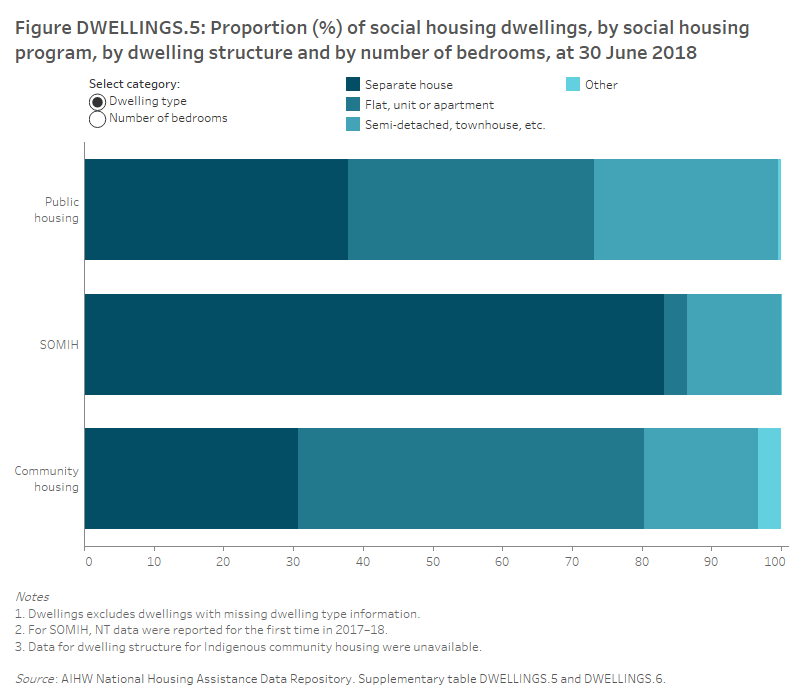
The size of social housing dwellings also differed across program types (Figure DWELLINGS.5):
- public housing dwellings were most likely to be 3 bedroom dwellings (37%), followed by 2 bedroom dwellings (31%).
- the majority of SOMIH dwellings were 3 bedroom dwellings (59%), with very few 1 bedroom dwellings (2%).
- community housing dwellings were most commonly 2 or 1 bedroom dwellings (36% and 32%, respectively).
- half of Indigenous community housing dwellings were 3 bedroom dwellings (50%) and a further 25% were 4 bedroom dwellings. Similar to SOMIH, very few were 1 bedroom dwellings (3%).
Over time, the proportion of public housing dwellings that have 3 bedrooms has declined from 39% in 2011–12 to 37% in 2017–18. This is also the case for SOMIH dwellings (down from 62% in 2011–12 to 59% in 2017–18) (Supplementary table DWELLINGS.S4.).
Number of dwellings managed
Community housing providers
At 30 June 2018, the majority of community housing providers in all states and territories, except Western Australia, the Australian Capital Territory and South Australia, were managing less than 50 dwellings (Table DWELLINGS.2). New South Wales (147 organisations) had the most community housing providers, and most of these providers managed less than 20 dwellings. Queensland (143) had a similarly high number of community housing providers; again, most managed less than 20 dwellings. New South Wales also had the highest number of community housing providers that managed 200 or more dwellings (25 organisations).
| Number of dwellings(a)(b) managed | NSW | Vic | Qld | WA | SA | Tas | ACT | NT | Total |
|---|---|---|---|---|---|---|---|---|---|
|
Less than 20 dwellings |
86 |
50 |
78 |
7 |
15 |
36 |
2 |
27 |
301 |
|
20–49 dwellings |
15 |
18 |
29 |
8 |
9 |
12 |
2 |
5 |
98 |
|
50–99 dwellings |
18 |
8 |
13 |
6 |
1 |
3 |
1 |
1 |
51 |
|
100–199 dwellings |
3 |
6 |
11 |
3 |
5 |
1 |
0 |
0 |
29 |
|
200 or more dwellings |
25 |
8 |
12 |
9 |
12 |
5 |
2 |
0 |
73 |
|
Total organisations |
147 |
90 |
143 |
33 |
42 |
57 |
7 |
33 |
552 |
(a) For community housing, tenancy (rental) units are reported as these are equivalent to dwellings in other housing collections.
(b) Community housing organisations for which the count of tenancy rental units is unknown are included under 'Less than 20'.
Source: AIHW National Housing Assistance Data Repository. Supplementary table DWELLINGS.7.
Indigenous community housing providers
At 30 June 2018, most (73%, or 156 organisations) Indigenous community housing providers were managing less than 50 dwellings (Table DWELLINGS.3). New South Wales had the highest number of Indigenous community housing providers (over 100 organisations). Just over half (52%) of these New South Wales providers managed fewer than 20 dwellings.
|
Number of dwellings(a)(b) managed |
NSW |
Vic |
Qld |
WA |
SA |
Tas |
ACT |
NT |
Total |
|---|---|---|---|---|---|---|---|---|---|
|
Less than 20 dwellings |
62 |
3 |
5 |
0 |
1 |
0 |
. . |
11 |
82 |
|
20–49 dwellings |
43 |
8 |
7 |
0 |
6 |
1 |
. . |
9 |
74 |
|
50–99 dwellings |
9 |
2 |
2 |
1 |
1 |
1 |
. . |
10 |
26 |
|
100–199 dwellings |
4 |
0 |
3 |
0 |
0 |
0 |
. . |
5 |
12 |
|
200 or more dwellings |
1 |
1 |
11 |
5 |
1 |
0 |
. . |
0 |
19 |
|
Total organisations |
119 |
14 |
28 |
6 |
9 |
2 |
. . |
35 |
213 |
. . Not applicable
(a) Only includes funded Indigenous community housing organisations (ICHOs). Where a state or territory housing authority is responsible for managing ICH tenancies for Indigenous people, they are classified as an ICHO for reporting purposes. The ACT does not have an Indigenous Community Housing program.
Source: AIHW National Housing Assistance Data Repository. Supplementary table DWELLINGS.7.
Occupancy rates
Occupancy rates describe whether a dwelling is occupied under a formal tenancy. In social housing, occupancy rates are influenced by tenancy turnover, housing supply and demand as well as the need for the redevelopment or replacement of dwellings. At times, major maintenance work needs to be completed before dwellings can be allocated to a new household.
At 30 June 2018, public housing and SOMIH both had 97% occupancy rates, slightly higher than community housing (95%). Indigenous community housing had lower occupancy rates of 93% (Supplementary table DWELLINGS.2).
There was some diversity in the occupancy rates for public housing when considering remoteness areas. Occupancy rates were higher for public housing dwellings in Major cities (97%) and Inner regional areas (97%) and lowest in Remote (95%) and Very remote areas (92%) (Supplementary table DWELLINGS.S2).
Tenantability relates to whether dwellings provide a certain level of basic amenity, and that maintenance is completed to the required minimum level. At 30 June 2018, almost all (98%) public housing dwellings were tenantable, slightly higher than the proportion of SOMIH (96%) and community housing dwellings (95%) (Supplementary table DWELLINGS.S1).
Glossary
References
- ABS (Australian Bureau of Statistics) 2015. Household and Family Projections, Australia, 2011 to 2036. ABS Cat. no. 3236.0. Canberra: ABS.
- AIHW (Australian Institute of Health and Welfare) 2019. National Social Housing Survey 2018. Cat. no. HOU 311. Canberra: AIHW.
- ABS 2016. Australian Statistical geography Standard (ASGS): Volume 1 – Main Structure and Greater Capital City Statistical Areas. July 2016. ABS Cat. no. 1270.0. Canberra: ABS.


